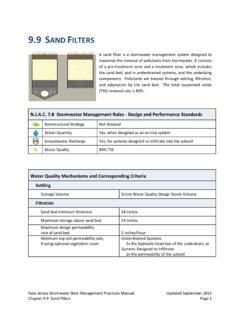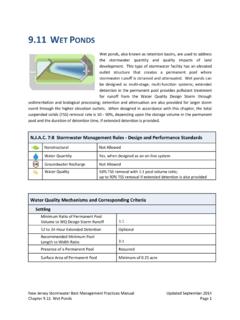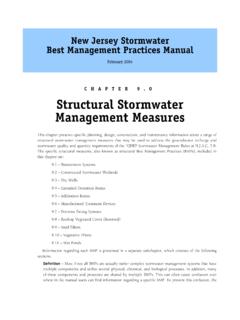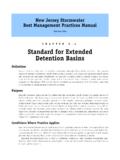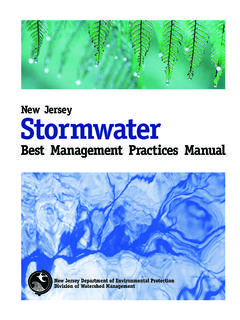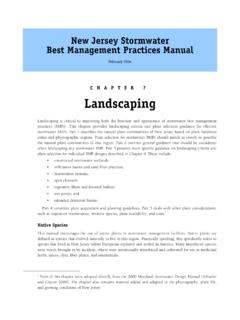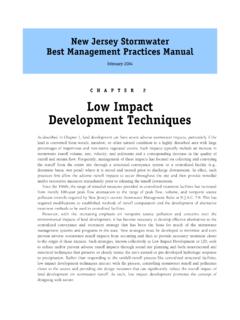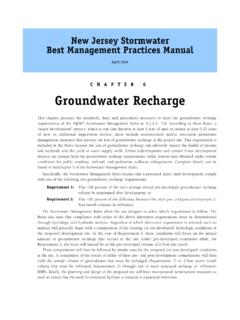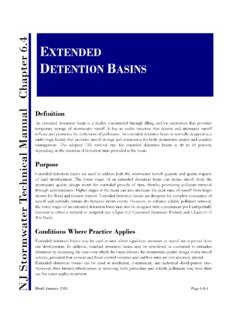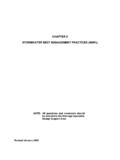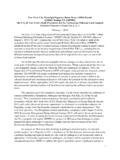Transcription of 9.12 GRASS SWALES - njstormwater.org
1 New Jersey stormwater Best Management Practices Manual Updated September 2014 Chapter GRASS SWALES Page 1 GRASS SWALES A GRASS swale is a stable, parabolic or trapezoidal channel that is lined with turf; it is used to improve water quality and convey stormwater runoff. GRASS SWALES do not rely on the permeability of the underlying soil for pollutant removal; instead, pollutants are removed by settling and filtration through the GRASS . The maximum total suspended solids (TSS) removal rate is 50%. 7:8 stormwater Management Rules - Design and Performance Standards Nonstructural Strategies Assist with Strategies #4 and 8; See Page 2 Water Quantity Not Allowed Groundwater Recharge Not Allowed Water Quality 50% TSS Water Quality Mechanisms and Corresponding criteria Settling Minimum Length 50 feet Manning s n value for Water Quality Design Storm Vegetative Uptake and Filtration Minimum Density of Vegetation 95% GRASS Height Between 3 and 6 inches Longitudinal Slope Between 2 - 10% Minimum Required Length For 50% TSS Removal Rate: 50 Feet - singular point of inflow 200 Feet - continuous inflow along entire length Flow Characteristics Maximum 2-inch depth Maximum velocity feet/second Must fully drain within 72 hours New Jersey stormwater Best Management Practices Manual Chapter GRASS SWALES Updated July 2014 Page 2 Introduction GRASS SWALES are turf lined channels used to convey and treat stormwater .
2 SWALES reduce suspended particles through filtration and settling and are best suited to treat runoff generated from impervious surfaces of small drainage areas. Typically GRASS SWALES are installed in low-gradient lawns, median strips, parking lot islands, unused lot areas and utility easements, where downstream flow attenuation is provided to control larger storm events. GRASS SWALES can be used wherever soil conditions, slopes and sunlight permit the establishment and maintenance of a dense stand of vegetation. Low velocities and shallow depths of runoff generated by the Water Quality Design Storm allow for particulate settling; while at the same time, the blades of GRASS in the swale filter the suspended solids. Because these pollutant removal mechanisms do not rely on infiltration into the subsoil, soil permeability is not a design consideration.
3 For larger storm events, the swale can be designed to convey stormwater downstream. GRASS SWALES must have a maintenance plan, and, if privately owned, must be protected by easement, deed restriction, ordinance or other legal measure that prevents its neglect, adverse alteration or removal. Applications The nonstructural stormwater management strategies design standard in the stormwater Management rules must be addressed for all major development, pursuant to 7 (a). The site evaluation for nonstructural strategies must consider all nine strategies. The design of a GRASS swale could assist in maximizing the following strategies: Strategy #4: The minimization of the decrease in time of concentration; Strategy #8: The provision of vegetated, open-channel conveyances.
4 Additional information on nonstructural stormwater management strategies can be found in Chapter 2: Low Impact Development Techniques. GRASS SWALES may be designed to convey storm events larger than the Water Quality Design Storm; regardless of the design storm chosen, all GRASS SWALES must be designed for stability and capacity in accordance with the Standards for Soil Erosion and Sediment Control in New Jersey, as required by 7:8 stormwater Management rules. To receive credit for a maximum of 50% TSS removal rate, GRASS SWALES must be designed to treat the Water Quality Design Storm and in accordance with the all of the criteria below. New Jersey stormwater Best Management Practices Manual Chapter GRASS SWALES Updated July 2014 Page 3 Design criteria Basic Requirements There are two categories of GRASS SWALES ; the following design criteria apply to all categories and must be met in order to receive a TSS removal rate for this BMP.
5 It is critical that all GRASS SWALES are designed in accordance with these criteria in order to ensure proper operation, to maximize the functional life of the system, and to ensure public safety. For criteria specific to each category, see the applicable section, beginning on page 6. Cross-Sectional Geometry GRASS height must be established and maintained between 3 and 6 inches. The swale may be trapezoidal or parabolic, with a bottom width between 2 and 10 feet. The maximum allowable side slope is 3:1, with a recommended side slope of 4:1. There must be a minimum separation of 1 foot between the bottom of the swale and the seasonal high water table (SHWT). swale Cross-Section Flow Characteristics The runoff depth must be calculated using Manning s Equation with a Manning s n value of This Manning s n value may only be used with the Water Quality Design Storm for TSS removal.
6 The maximum allowable depth of runoff in the swale is 2 inches. The maximum allowable velocity is feet/second. All standing water must drain from the surface of the GRASS swale within 72 hours. New Jersey stormwater Best Management Practices Manual Chapter GRASS SWALES Updated July 2014 Page 4 Longitudinal Geometry The minimum longitudinal slope is 2%. In situations where the design criteria cannot be met using the 2% slope, such as when runoff velocity exceeds the maximum of feet per second, this slope may be reduced to At this reduced slope, some infiltration of runoff into the subsoil will be necessary in order for the swale to drain in the required 72 hours. Therefore, for any GRASS swale designed with a slope less than 2%, a minimum 2-foot separation from the SHWT and a field-tested subsoil permeability rate of at least 1 inch/hour in accordance with the soil testing procedures found in Appendix E are required.
7 GRASS SWALES may not be used to meet the groundwater recharge requirement at 7 (a)2. The maximum longitudinal slope is 10%. In order to receive the 50% TSS removal rate for the entire length of a Point Inflow GRASS swale , the minimum swale length is 50 feet. In order to receive the 50% TSS removal rate for the entire length of a Linear Inflow GRASS swale , the minimum swale length is 200 feet; however, for SWALES with lengths less than 200 feet, a weighted average may be achieved. See Example 5 for more information on calculating TSS removal rates using a weighted average. Stability GRASS SWALES must be stabilized in accordance with the current version of Standards for Grassed Waterways in the Standards for Soil Erosion and Sediment Control in New Jersey. New Jersey stormwater Best Management Practices Manual Chapter GRASS SWALES Updated July 2014 Page 5 Types of GRASS SWALES There are two types of GRASS SWALES : 1.
8 Point Inflow 2. Linear Inflow Runoff enters a Point Inflow GRASS swale at a single location, such as a pipe. A Linear Inflow GRASS swale receives distributed runoff along its entire length; a GRASS -lined ditch along an uncurbed section of roadway is an example of a Linear Inflow GRASS swale . TSS removal rates vary depending on the type and configuration of the swale . The section beginning on page 6 provides examples of how to calculate the TSS removal rate for different configurations. Regardless of the design, all of the criteria in the basic requirements section must be met in order for the swale to receive a TSS removal rate. The following checklist and flowchart may be helpful in determining the TSS removal rate for a particular GRASS swale . GRASS swale Checklist and General Flow Chart Individual Types of GRASS SWALES This section provides detailed design criteria for each GRASS swale category.
9 The illustrations depict possible configurations and flow paths and are not intended to limit the design. New Jersey stormwater Best Management Practices Manual Chapter GRASS SWALES Updated July 2014 Page 6 Point Inflow GRASS SWALES Example 1 shows a 50-foot Point Inflow GRASS swale receiving runoff from an impervious area; the inflow enters at the upstream end of the 50-foot swale . Because all of the runoff produced by the drainage area is collected prior to entering the swale , and assuming that all of the other design criteria for water quality are met, the entire inflow drainage area receives the 50% TSS removal rate. Example 1: In Example 2, the swale length does not meet the minimum requirement of 50 feet; therefore, this Point Inflow GRASS swale achieves a TSS removal rate of 0% and no TSS removal credit is allotted to the inflow drainage area.
10 Example 2: New Jersey stormwater Best Management Practices Manual Chapter GRASS SWALES Updated July 2014 Page 7 Linear Inflow GRASS SWALES The following graphic illustrates the gradient of pollutant removal within a 200 foot Linear Inflow GRASS swale . Because GRASS SWALES treat runoff through vegetative uptake and filtration, the amount of treatment increases with increased flow lengths. Runoff entering at the downstream end receives much less treatment than runoff entering upstream. Moreover, runoff must travel farther than 50 feet for adequate treatment. For calculation purposes, the required downstream 50-foot section of a Linear Inflow GRASS swale is awarded a 0% TSS removal rate. However, SWALES 200 feet in length are awarded a 50% TSS removal rate, provided that they meet all other criteria , because the runoff entering upstream receives enough treatment to compensate for the low level of treatment in the downstream section, as shown in Example 3 on the following page.
